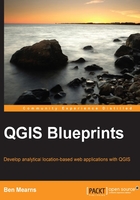
About the Reviewers
Ujaval Gandhi holds a master's degree in the field of geoinformatics from the University of Wisconsin-Madison, and he has 10 years of experience in the field of remote sensing and GIS. Ujaval is passionate about open source software and an active contributor to the QGIS community. He is currently located in Bangalore, India, and works as a tech manager in the aerial imagery team at Google.
Fred Gibbs is an assistant professor of history at the University of New Mexico, where he teaches the intersection of the history of medicine and urban ecologies, particularly the spatial relationships between people, food, health policy, public health, and urban design. In his research, Fred experiments with new, technology-driven methodologies to create and disseminate historical interpretations. His recent work focuses on creating interactive maps to visualize and understand urban spatial experiences and health. Fred coaches students on the history of medicine, food history, urban health, and digital humanities.
Gergely Padányi-Gulyás is a geographic information systems (GIS) developer, web developer, and remote sensing analyst with over 7 years of experience. He specializes in designing and developing web mapping applications and GIS. Gergely is a dedicated user and developer of open source software (OSS) and also an active member of the Hungary OSGeo chapter. He is familiar with both client- and server-side programming.
For more than 4 years, Gergely worked for archaeologists as a GIS engineer and remote sensing analyst, where he contributed to laying the foundations of archaeological predictive modeling in Hungary. After this, he became a Java web developer in a private company. For the last 2 years, Gergely has been working at a state nonprofit corporation as a lead GIS and web developer, where he uses the experience he gained in his previous jobs: combining GIS with development. In the past few years, he dived into plugin development in different programming languages, such as Java for GeoServer and Python for QGIS. Quite recently, Gergely has been dabbling in WebGIS 3D visualization and analysis.
You can follow him on his personal website at www.gpadanyig.com.
Abdelghaffar KHORCHANI has a license degree in geographic information systems (GIS) and a fundamental license of natural science in applied biology and geology. He holds a master's degree in geomatics and planning, and he is also a computer engineer. Currently, Abdelghaffar is pursuing a master's degree in planning and regional development from Laval University, Canada and a PhD in marine sciences from the University of Milano-Biccoca, Italy.
He organized courses in Japan based on the fisheries resource management approach for young leaders. In Spain, Abdelghaffar designed courses that focus on the field use of GIS for scheduling and management. Besides, he has also devised courses on urban administration in Tunisia.
Abdelghaffar has 8 years of experience in the geomatics field and has worked on several projects in the sectors of agriculture, environment, transport, mapping, and so on. Currently, he manages the Ministry of Agriculture & Environment in Tunisia and is responsible for the mapping service in the vessel monitoring system (VMS) project.
Abdelghaffar is also a trainer in the mapping field of GIS, GPS, and computer-aided design (CAD). He is particularly interested in the development of decision support tools.
Pablo Pardo is a geographer from Spain. He has an MSc degree in GIS and specialized in natural risk assessment, focusing his thesis on open data quality. Pablo also has a certificate of higher education in software development.
After several years of working as a GIS technician, he is now beginning his freelance career, combining GIS consulting with data analysis and programming. This is the second book Pablo has helped review.
He likes open data, free software, and "geo stuff". You can find more information about him at www.pablopardo.es.
Mats Töpel received his PhD in systematic biology from the University of Gothenburg, where he studied evolutionary and biogeographical patterns in plants using GIS and climate niche modeling. He is currently working as a bioinformatician specialized in de novo genome sequencing. Mats is the lead programmer in the SpeciesGeoCoder project, a tool for large-scale biogeographical data analysis. When not involved in science, he enjoys spending time with the family or fly-fishing along the coast of Sweden.